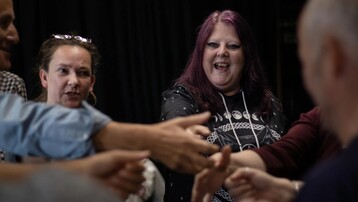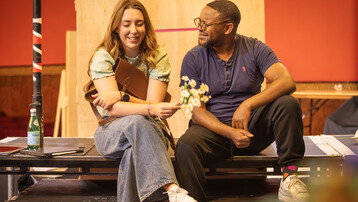News Story
A Story, A Story! Let it come, let it go!
This season, as a part of ETO Unboxed, a programme of live and digital events exploring the multi-disciplinary and multi-genre nature of opera, we are excited to present an enchanting evening of musical storytelling in A story, a story! Let it come, let it go! This intimate and evocative series of chamber operas explores the tales that shape who we are. Below, hear insights on this new production from Director Monica Nicolaides.

Monica Nicolaides
Director's Notes
A promenade performance is about taking the audience on a journey, both figuratively and literally. It is about transporting the audience in a world they can experience up close and personal. The barriers of conventional theatre and opera that separate the performers from the spectators are removed, and instead offer the audience the opportunity to choose the vantage point they want to experience the story from. When it is composed of four new opera works about story-telling, the oxymoron of the situation adds another level of complexity that enriches the experience all together.
In A story, a story! let it come, let it go! I was instantly inspired by how each piece responds to the senses and feelings we experience at each stage we connect with stories; as the creator, the narrator, and the audience. Each operetta touches on our relationship with fairytales, memories and stories that are remembered and passed in a different way; how they are conceived and narrated, how they are recalled and how they are experienced and interpreted. Each experience requires a different type of engagement and stimulates different senses in our bodies - hear, see, feel, tell. With each iteration the identity of the author is shared with every new narrator and the story gradually evolves offering different perspectives and levels to the narrative itself.
‘A Sparrow and Eagle’ highlights the sense of play and imagination of our inner child, where the search for adventure becomes the driving force in carving out this story. The three characters tap into their imagination, with the author’s identity shared amongst them. Creating a new story becomes a collective activity responding to the curiosity and wonder of what comes next. This becomes the impetus to follow our characters in their eager story hunt, and where our journey begins.
‘Once in a Garden’ inspired by the tale about ‘How a Husband weaned his wife from Fairytales’ playfully tests one of our characters quest for a new story. Glyn Maxwell’s libretto and Lucie Treacher’s composition play with cyclical patterns where the beginning of the tale is also the end. The infinite loop persists with the infamous beginning of fairytales ‘once in...’, a sense of familiarity and simultaneous discomfort, as if her memory fails her. The variation in the repetition wraps the passage of time as if the ending does not exist.
Contrary to the other three operettas, ‘The Knot’ seems to touch on the emotional experience rather than the series of events in a linear fashion. I couldn’t help thinking about the stories - whether fictional or memories - that are passed down from one generation to the next. Ironically, it feels that this opera focuses on the sentiment more than the events that transpired. The first image that came to mind, was someone suspended in time, searching for something they were missing, but they didn’t know what that something is. The second image was being transported into a memory of the past, where the edges are not quite clear, but the emotional connection to that memory is the key. ‘The Knot’ is about what is left unspoken and reading between the lines; it’s about the in between, and residue that stays with us well after the memory or story is finished.
‘A Herstory of daughters who won’t lissen’ brings us to a full circle addressing the purpose of a story; the moral. Inspired by the Nigerian folk tale of 'The disobedient daughter who married a skull' by Elphinstone Dayrell, it is a cautionary tale for women about conforming and the expectations of society for them. Chinonyerem Odimba and Charlotte Marlow’s piece focuses on a woman’s relationship with herself, the rebellious and independent part of herself that is constantly challenged by society’s expectations for the role of women. In our conversations, we talked about that part of every woman’s identity that challenges conformity and needs to experience life - mistakes included - first hand. We witness this in the relationship of the Medicine Woman, Jaja And Effy, where there is an inkling of herstory repeating itself - a story that every woman has to experience. In this piece each female character tackles the battle between expectation and independence in their own way. One as the person reliving the past, one experiencing it in her present and one by choosing to the break the cycle to change the youngest’s future. Female solidarity through herstory.
Story-telling is a portal into how we understand the world. Similar to memories, the way we experience a story alters every single time. When we recall an event, we don’t think of the first time we experienced the event, instead we go back to the last time we recalled the memory of the event. Hence the latest memory becomes the memory of the previous recollection. A story, a story! Let it come, let it go! is about our relationships with stories old and new. It explores who the author of a story really is, and how what we take away from them informs our relationship with others, with the world and more importantly with ourselves. Which is more important: the narrative, the moral or how it makes us feel?


